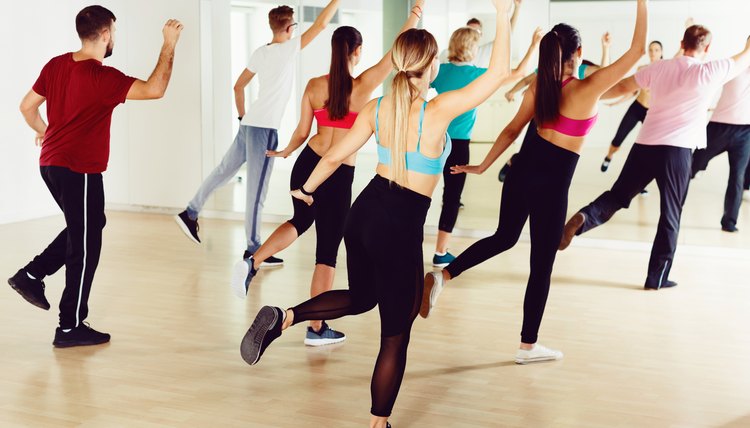How Does Dance Class Make One a Better Athlete?

Forty years ago, football hall-of-famer Lynn Swann was dubbed "Baryshnikov in cleats" for embracing dance as part of his unorthodox training discipline. Today, things are a little different.
From Emmitt Smith to Kristi Yamaguchi to Hines Ward, some of the most renowned athletes on the planet have been known to dance like there's no tomorrow. The physiological and mental benefits that attending a regular dance class provides make it a super smart addition to athletic cross-training, right alongside staples such as weightlifting, cycling and swimming — and that's totally separate from the fact that dancing is just really fun to do.
Going Strong
One quick look at the physical benefits regular dance provides, and it's little wonder athletes get their groove on in class. If an athlete's body is their temple, dance makes the foundation strong.
Consistent dance practice increases muscular strength and endurance, boosts motor fitness, tones muscles and helps manage body weight. Hitting dance class hard for just a half an hour can burn upward of 300 calories, according to the University of Brighton. Additionally, dancing strengthens the bones, which is doubly important in contact sports such as football or rugby, which — per 2017 Yale University data — experience more than 600,000 injuries annually.
Going Long
Taking dance classes isn't all about getting stronger and leaner. As a form of cardiovascular exercise, dancing increases aerobic fitness. That means it bolsters endurance and helps athletes go longer and work harder on the field before getting winded.
Heart-pumping dance classes make for enhanced stamina and athletic endurance. Jean-Claude Van Damme, who was a professional kickboxer-slash-student-of-ballet before he was an action movie star, is quoted as saying, "If you can survive a ballet workout, you can survive a workout in any other sport."
Flexibility and Coordination
Because dance training involves the memorization and constant repetition of precise steps, it can also help athletes become more coordinated. More than that, dance classes that focus on group routines can sharpen spatial awareness, which is crucial to sports that require athletes to track a tiny ball across a playing field that's dozens of yards long.
Likewise, dance moves that really make the body stretch — like splits or ballet's high-stepping grand adage — encourage greater flexibility. Think of it as a higher impact version of yoga.
All that stretching on the barre helps, too. The Wall Street Journal reports that when the San Francisco 49ers implemented stretching into all aspects of their player training around 2013, their injury rates hit rock bottom — teams that didn't stretch as much racked up injury rates as much as 176 percent higher.
Brain Benefits
Aside from sculpting the body, regular dance training also helps athletes keep their minds in peak condition by consistently exercising their cerebral and cognitive thought processes alongside their muscle memory.
According to studies from Imperial College London, years of dance training doesn't only increase balance, it can even reduce how prone dancers are to dizziness. Meanwhile, a Psychological Science study reports that dancers are more capable of performing complex physical moves with less mental strain. If you've ever seen a Maradona turn to a bicycle kick on the soccer pitch, you'll know exactly why that's an invaluable advantage for an athlete to have, too.
References
- BetterHealth Channel: Dance — Health Benefits
- WBUR: Dancing with the Athletes: When Sports and Dance Collide
- Los Angeles Times: Sixteen Things You Might Not Know About Lynn Swann
- The New York Times: Cost of Contact Sports Is Estimated at Over 600,000 Injuries a Year
- Time: Why Dancing Is the Best Thing You Can Do for Your Body
- Psychology Today: Why Is Dancing So Good for Your Brain?
- Mejia-Downs A, Fruth SJ, Clifford A, et al. A Preliminary Exploration of the Effects of a 6-week Interactive Video Dance Exercise Program in an Adult Population. Cardiopulm Phys Ther J. 2011;22(4):5‐11.
- Harvard Health Publishing. Calories burned in 30 minutes for people of three different weights. Updated August 13, 2018.
- Çakir-Atabek H, Aygün C, Dokumacı B. Active Video Games Versus Traditional Exercises: Energy Expenditure and Blood Lactate Responses. Res Q Exerc Sport. 2020;91(2):188-196. doi:10.1080/02701367.2019.1653431
Writer Bio
In addition to fitness experience including USFCA fencing discipline, stage combat, track and equestrian training, Dan has contributed health and fitness-oriented content to AZCentral, SportsRec, JillianMichaels.com, ModernMom, The Nest and more.
